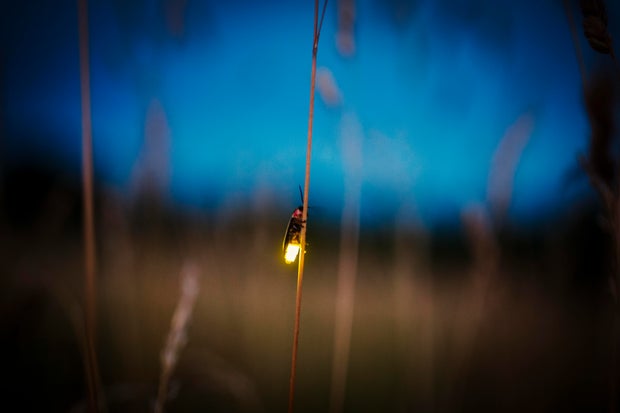Firefly fans who would like to see fireflies year-round are out of luck.
O The insect, which is a species of beetle, is usually only seen between spring and summer, with different species appearing at different times. The first fireflies of the season appear later in the year as you head north.
The fireflies that people see glowing and flying are adults, said Sara Lewis, author of “Silent Sparks: The Wonderrous World of Fireflies.” The time they spend on the surface before dying is brief, with fireflies spending most of their lives living underground.
“One of the most surprising things about fireflies is that the ones we’re used to seeing — the ethereal, enchanting adults that fly around in the summer — they have a backstory,” Lewis said. “They are just the end of the firefly’s life cycle.”
The firefly life cycle
During their brief time as adults, fireflies focus on reproduction. Some are so focused on it that they don’t even eat, according to US Fish and Wildlife Service.
Getty Images/iStockphoto
Most firefly species in the U.S. — there are about 170, according to Lewis — lay eggs in soil, moss or at the base of plants. They look for moist areas because the eggs are tiny, soft and dry easily. It takes about two weeks for firefly larvae to hatch.
“If they dry out during that time, they are dead,” Lewis said.
The eggs are about the size of a pinhead, according to Candace Fallon, senior conservation biologist at the Xerces Society for Invertebrate Conservation.
After the eggs hatch, the larvae burrow into the soil, where they spend one to two years, depending on the species. After the larval stage, there is a brief pupal stage before the adults emerge.
Growing underground
Although juvenile fireflies glow, they are very different from the adults people are used to seeing.
“Adult fireflies are just the tip of the firefly iceberg,” Lewis said.
While adults on the surface focus on reproduction, fireflies are similar to teenagers in their juvenile phase: focused on eating and growing, Lewis said. They eat snails, slugs and earthworms. They have sharp jaws and inject paralyzing neurotoxins into their prey.
“The larvae are incredibly voracious predators, they are really ferocious,” Lewis said.
When cold weather arrives, the larvae burrow below the frost level and don’t move until it warms up in the spring, when they begin burrowing again, Lewis said.
The larvae also don’t look like the adult fireflies people are used to seeing; they look more like bed bugs, commonly known as chubby bugs.
After the larval stage, fireflies go through a short pupal stage before emerging as adults.
The next generation of fireflies
Adult fireflies in the southern U.S. begin emerging in March, April and May, while they begin emerging in June and July further north, Fallon said.
There are three general types of fireflies in the U.S., Fallon said. There are diurnal dark fireflies, which are active during the day and use pheromones instead of lights to communicate. There are also fireflies. Male fireflies, which generally do not light up, have huge eyes. They look for flightless females that emit little light on the ground.
Haoxiang Yang via Getty Images
There are the shiny species, which is the type most people recognize.
“These flashes are directly related to courtship in adults. Each species uses a species-specific flash pattern,” Fallon said. “Normally, males will be flying around flashing a specific single, looking for a female. And if a female is interested, she will have her own specific flash that she will transmit to that male.”
When not searching for a mate and focusing on reproduction, fireflies may rest in bark crevices or vegetation. They stay in areas where they can get some protection from predators and in moist areas.
Threats faced by fireflies
Fireflies need moisture in each of their life cycles, Lewis said. It’s not just eggs that can dry out; Larvae and pupae can also dry out and die if there is not enough moisture. Drought is one of the most serious threats facing fireflies.
About 10% of firefly species in the U.S. are not doing well, Lewis said. Some of firefly species most vulnerable to extinction they need very specific habitats to survive.
Light pollution is also a threat to fireflies. It can prevent male and female fireflies from meeting so they can mate, reducing the population of the next generation of fireflies.
National Park Service
“Love can be hard to find for even the brightest fireflies,” according to the Fish and Wildlife Service. “Even the interfering light of the full moon can obscure their visual Morse code, making it impossible for men and women to recognize each other. Light pollution from cities, factories and roads has seriously killed the buzz of these insects.”
Excessive use of pesticides is also affecting firefly species everywhere. Fallon advises being careful about fireflies when caring for lawns. She suggests mowing the lawn less frequently or leaving the grass taller. If possible, leave a corner of the yard a little wild so that the fireflies – eggs, larvae, pupae and adults – have a safe space.
The advice applies all year round, not just in spring and summer when flashes of light are visible.
“Many people only think of fireflies when they are adults blinking for a few weeks in the summer, but the reality is they are present year-round, we just don’t notice or see them,” Fallon said.
mae png
giga loterias
uol pro mail
pro brazilian
camisas growth
700 euro em reais























